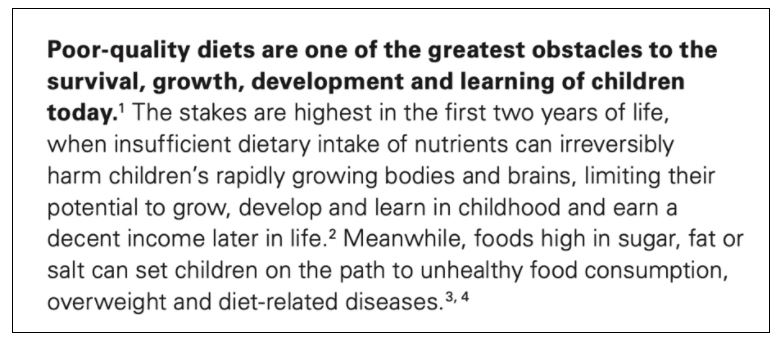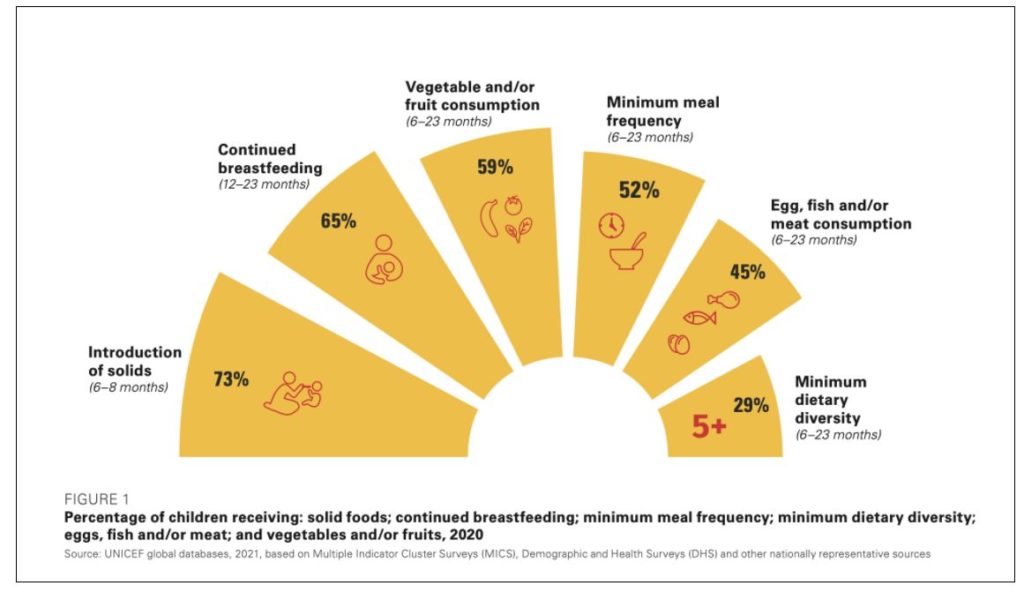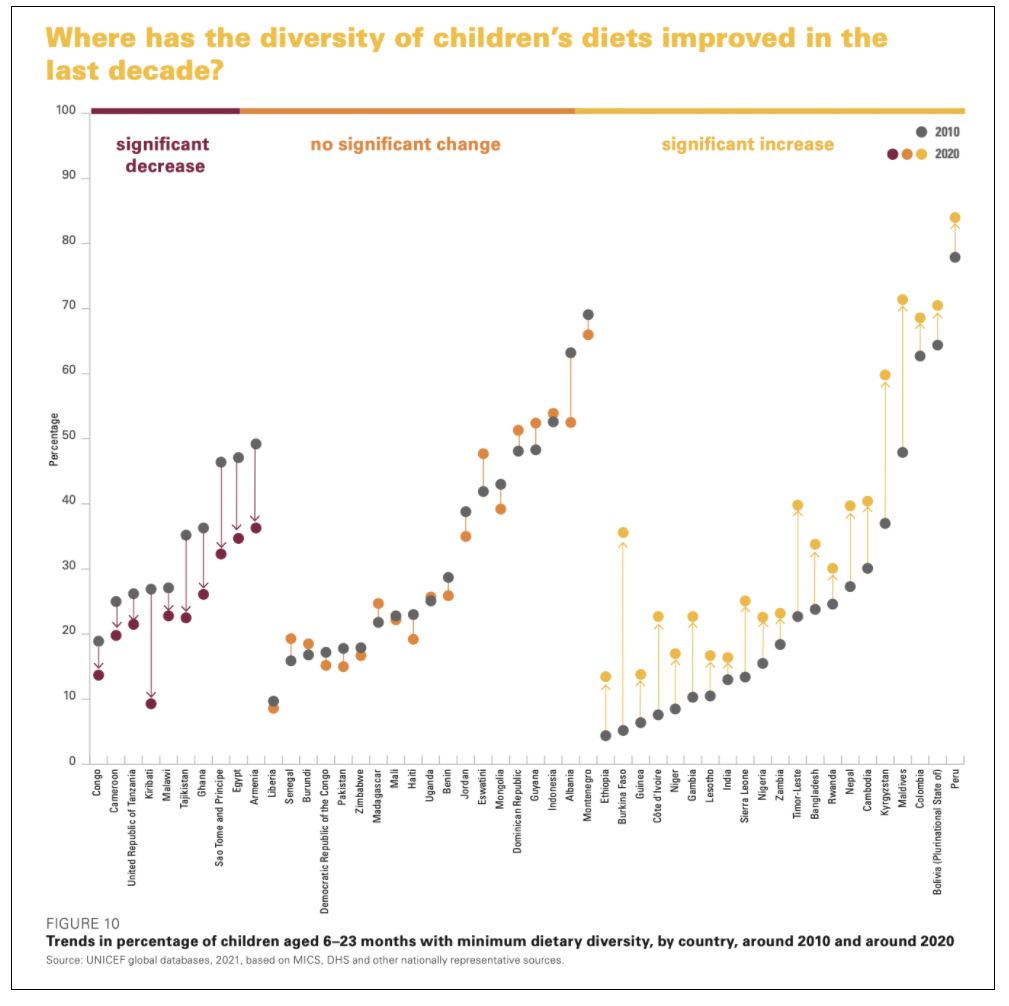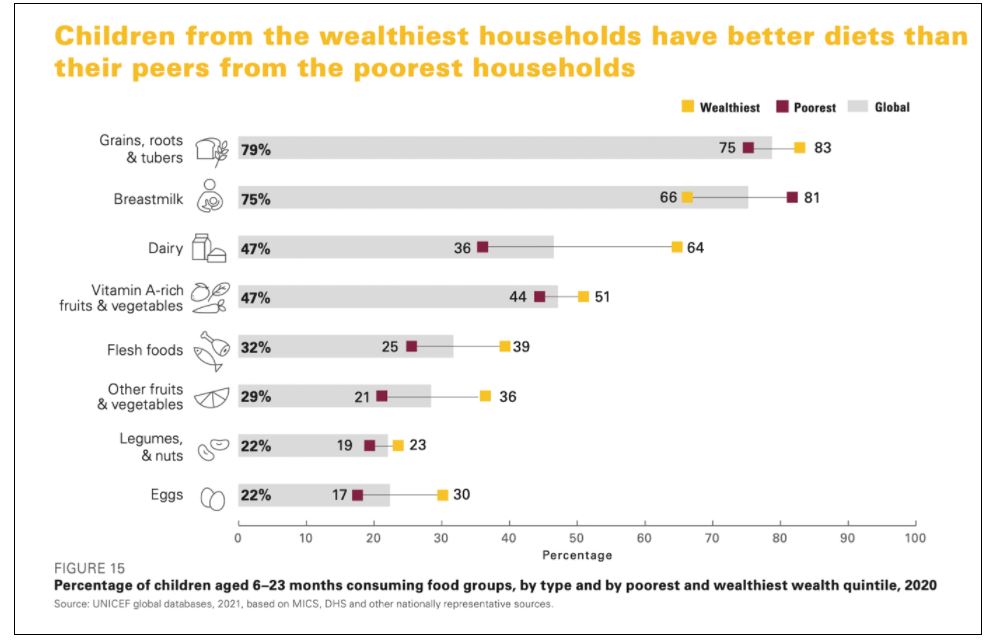UNICEF’s 2021 report titled ‘Fed to Fail? The crisis of Children’s diet in early life’ highlights the progress or the lack of it in addressing child malnutrition indicators around the world. While significant progress has been made in some countries in few of the indicators, large sections of the world population are still suffering from this scourge.
Nutritious food during the early ages is key to child development and has a life-long impact. The United Nations International Child Emergency Fund (UNICEF) has recently released the Child Nutrition Report – 2021 titled “Fed to Fail ? The crisis of Children’s diet in early life”. The report explores the data related to the various trends & inequities in the diets of young children (6-23 months) and the barriers for providing age-appropriate nutritious food.
In its opening remarks, the report highlights the importance of nutritious food during early childhood and its future impact.

In this story, we review the important observations, findings & recommendations from the report. We also look at the data made available in the report about the trends across countries as well as explore these numbers in the context of India.
Source of Data & Information:
The report is based on data from the UNICEF Global Database on Infant and Young Child Feeding. This database comprises of nationally representative data from 607 surveys conducted across 135 countries & territories. This is representative of nearly 90% of children under the age of 2, globally. The information is also based on analysis of national policies & programmes relating to provision of nutrition to children across seven geographical regions. Other sources include – Focus group discussions, Research relating to COVID-19 impact and review of global literature regarding child feeding practices & diets.
Significant progress made over the past two decades, but a lot is to be achieved yet
The report notes that over the last two decades, significant progress has been made in addressing malnutrition in children below 5 years. Four forms of malnutrition are highlighted by UNICEF are – Stunting, Wasting, Micronutrient deficiency & Overweight.
The report observes that over the last two decades, the global prevalence of child stunting fell by one-third to 22%. The number of children with stunted growth reduced by around 55 million. While this is a significant achievement, the report observes that there is a collective failure globally in protecting the right of children to food and nutrition. As per the Convention on Rights of the Child, governments have a legal obligation to protect and fulfill the right to food and nutrition for all children. As per the estimates,
- Around 149.2 million children under the age of 5 years globally have stunted growth.
- Nearly a 1/3rd i.e., 51 million children suffering from stunting are under the age of 2 years.
- 45.4 million children under the age of 5 suffer from wasting. This accounts for around 6.7% of the children under 5 years. Wasting refers to the child being too thin for height. Among them, 23 million are under the age of 2 and suffering from wasting.
- 340 million children who are underage of 5 suffer from deficiencies in vitamins and other essential micronutrients like vitamin A, iron, iodine, zinc, etc.
- There is an increase in the number of children under 5 years, who are suffering from being overweight. Over the last two decades, it increased from 33.3 million to 38.9 million.

From a geographical perspective, South Asia has the highest prevalence of Stunting with 53.8 million of its children under 5 suffering from the same. However, this is a remarkable improvement from about 86.8 million children in 2000.
Among the 7 geographical regions categorized in the report, all the regions except two have seen a reduction in the number of children suffering from stunting in the last two decades. While Eastern & Southern Africa reported a slight increase, the number of children suffering from stunting increased from 22.8 million to 29.3 million in West & Central Africa.
Regarding wasting, South Asia has the highest proportion of its children suffering from it with 14.7%. The global increase in overweight children is contributed by the increase in the Middle East & North Africa, East Asia & Pacific and Latin America & Caribbean regions.
Little to no improvement in Children’s diet over the last decade
Findings from the report further highlighted that majority of the children across the globe are not being fed the right food at the right time. It is important to introduce the right foods at the right age to aid in proper growth & development. The report notes the following about Children’s diet.
- 73% of children between 6-8 months are fed any solid foods.
- 52% of the children between 6-23 months are fed with a minimal meal frequency.
- Only 29% of the children have access to minimally diverse diets. Around two-thirds of the children in the 6-23 age group are not fed any diverse range of foods that are needed for healthy growth & development.
- 41% of children are not being fed nutrient-rich foods like Foods & vegetables and 55% of the children do not have access to other nutrient-rich foods like eggs, fish & meat.

Based on an analysis of the data available from 50 countries, the proportion of children consuming a minimally diverse diet remains low with only an increase from 21% in 2010 to 24% in 2020. Among these, only 21 countries have reported a significant improvement in the diversity of children’s diets. Another 10 countries have reported a significant decrease in the diversity of the diets. India is among the countries that have shown a significant increase.
The data does not account for the impact of COVID-19, which could have impacted millions of families in the ability to provide nutritious food due to loss of income, reduced access to nutritious food in view of pandemic-related control measures.

Disparity exists based on Income but not on Gender
According to the findings in the report, a major disparity exists between the regions and between the countries within a region. Regions that are poorer economically – Eastern and southern Africa, South Asia and West & Central Africa have the lowest rates of meal frequency, dietary diversity, and consumption of nutritious food.
Varying trends are observed among the regions:
- 62% of children (6-23 months) in Latin America & the Caribbean were fed a minimally diverse diet compared to less than 25% of young children in South Asia and Sub- Saharan African regions of – Eastern & Southern Africa and West & Central Africa
- 70% of children in Latin America & the Caribbean along with East Asia & the Pacific consume more nutritious food due to the intake of eggs, fish or meat compared to less than 50% in Sub-Saharan Africa and less than 24% in South Asia.
- South Asia and two sub-Saharan African regions have fewer children who benefit from all recommended feeding practices.
- Meanwhile, South Asia and the two Sub-Saharan regions have a higher percentage of children who were breastfed in the second year of their life.
Furthermore, there seems to be a direct correlation between income and the availability of nutritious food. It is less likely that children living in poorer households and rural areas consume sufficient meals and have diverse diets. The scope of these children being breastfed into the second year of their life is low.
There is not much difference observed in the change in feeding practices between poorer and wealthier households over the decade. Within the countries, huge disparity exists among the children based on the income of the households. For example, in Peru, there is a 30-percentage points gap between the best and worst-performing areas. The same can be said about Ethiopia. Hence national averages mask the disparity within the countries.

While the difference is stark in the case of the Rural-Urban and Poor-Wealthy divide, the same is not the case with the gender divide. To the extent of feeding children, wealth & location seem to have a higher influence in driving disparity than gender.

However, some of the findings from the report reveal that social, cultural & gender barriers have an influence on Children’s diets. COVID-19 pandemic has further worsened the situation for the marginalized households. Studies conducted in countries of Eastern & Southern Africa; Indonesia & Nepal reveal this trend.
Another important impact on nutritious food of children is that of unhealthy processed foods that are easily accessible. India leads among ‘Confectionary’ with 30% of the children under the age of two years consuming it. India is also among the top-5 select countries in consumption of ‘Sugar’, ‘Sweet drinks’ & ‘Instant Noodles’ by these young children.
India is among the countries that made better progress in addressing malnutrition
In an earlier story based on data from NFHS (National Family & Health Survey) & CNNS (Comprehensive National Nutritional Survey), we observed that India has made significant progress over the last 15 years in addressing malnutrition in children. Larger gains were made regarding children suffering from stunting and underweight. There is also a marginal fall in the number of children impacted by ‘Wasting’.
As per the data in the UNICEF report, India has been performing well especially regarding the reduction in the children affected due to Stunting. In 2012, 42% of the children were impacted by stunting, which fell to 31% in 2020. Cote d’Ivoire was another country that recorded an 11% contraction in the proportion of children suffering from stunting. Other South Asian countries of Nepal, Bangladesh & Pakistan have also shown improvement in the situation of children affected by stunting.
While the improvement in these countries including India is remarkable, it ought to be noted that the number of children affected by these conditions is still high. Developed countries like the USA & Germany have only around 2% of the children affected by stunting. Meanwhile, the situation is worse in a few of the African countries like Libya & Angola.
However, as per UNICEF data, India is off track as far as children ‘wasting’ is considered. About 17% of the children are categorized under ‘moderate – severe’ status while another 5 % are categorized under ‘severe’ as per the standards set by WHO. As already highlighted, the NFHS & CNNS also point out that the progress in the case of children being wasted is much less compared to the progress made in stunted children.
Among the other South Asian countries, Pakistan is ‘on track’ while Bangladesh & Nepal are ‘off track’ like India as far as ‘wasting’ is considered. Many of the African countries are also ‘off track’.
Need for greater accountability regarding Children’s Diets
The report observes that Children’s diets are failing in – timeliness, meal frequency and dietary habits. These have barely improved over the decade and contribute towards the higher prevalence of malnutrition. Few of the major barriers identified in the report include;
- Unavailability, inaccessibility, and unaffordability of good food. Children from poorer households and those living in disadvantaged rural areas have lesser access to nutritious diets.
- Traditional values and views about food influencing the choice of caretakers feeding the children.
- Responses from the governments do not fit in addressing the nutritional issues of the children.
- Availability of cheaper processed and ultra-processed foods

As highlighted earlier, the ‘Convention on Rights of the Child’ states that governments have a legal obligation to ensure the right to food & nutrition of children. The report thus suggests that the governments need to take a lead in ensuring this right of the child. It proposes action from the government to formulate policies & mobilize resources relating to the three systems of – food, health & social protection. The report lays down suggestive actions to be taken across the three systems and also develops multi-system governance for initiatives that do not fall in any of these three. In other words, the report calls for greater government accountability regarding Children’s diets
Featured Image: UNICEF’s Child Nutrition Report


